Gum disease caries is much more common in people of any age. But inflammatory and carious lesions of the mouth mainly have a common etiology: violation of hygiene rules, changes in the hormonal background. The health of the entire oral cavity depends on the condition of the gums, so it is important to know what periodontal ailments occur, how they manifest themselves, and how they are treated.
Record content:
- 1 Classification
-
2 Gingivitis
- 2.1 Views
- 2.2 Stages and degrees
- 2.3 Symptoms
- 2.4 Possible reasons
- 2.5 How to treat
-
3 Periodontal disease
- 3.1 Views
- 3.2 Stages and degrees
- 3.3 Symptoms
- 3.4 Possible reasons
- 3.5 How to treat
-
4 Periodontitis
- 4.1 Views
- 4.2 Stages and degrees
- 4.3 Symptoms
- 4.4 Possible reasons
- 4.5 How to treat
- 5 Video about gum disease
Classification
The gum is a soft mucous tissue that completely covers the alveolar ridge of the jaw and reliably protects the roots of the teeth from environmental influences. Healthy gums have a light pink periodontal tint, no erosion or other formations.
Due to the vital activity of pathogenic microflora and the effect of various stimuli, the state of the gums changes, discomfort appears, telling about the development of pathology.

In dentistry, there are three main groups of gum disease:
| Ailments provoked by pathogenic microorganisms | This group includes a disease such as gingivitis, which indicates the presence of an underlying somatic illness. |
| Diseases of traumatic or infectious etiology | This category includes gingivitis of iatrogenic origin, which can be triggered by the presence of herpes simplex virus or yeast. |
| Ulcerative necrotic ailments | It manifests itself against the background of reduced immunity and general reactivity of the body due to the activation of the microbial association, consisting of fusobacteria and spirochetes. This group includes Vincent's gingivitis, which is often diagnosed in men under 30 years of age. |
Gingivitis
This is a gum disease that develops as a result of the inflammatory process. It is accompanied by bleeding, soft tissue swelling and redness.
More often this ailment is not independent, but only acts as a consequence of the presence of other diseases: periodontal disease or other infections. If the ailment is not treated, then the enamel will eventually be destroyed and the tooth will simply fall out.
Views
Dentists distinguish between several types of gingivitis, depending on the prevalence:
- Local. The disease affects the gums of one or several teeth at once, and also affects the space between the teeth.
- Generalized. The disease affects the entire jaw, the entire lower and upper dentition. If a person is diagnosed with such a diagnosis, then you need to undergo a comprehensive examination, as this indicates the presence of serious diseases in the body: diabetes, AIDS, immunodeficiency.
The form of inflammation is distinguished:
- Catarrhal. This is one of the most common forms that can occur in an acute or chronic stage. This form is characterized by severe inflammation, manifested in the form of swelling, severe pain and redness.
- Ulcerative. It is less common and is the outcome of the catarrhal form. It develops due to the presence of bacteria that have their destructive effect on the mucous membrane and, as a result, ulcers and pus appear.
- Hypertrophic. It proceeds in a chronic form, manifests itself as a result of a prolonged inflammatory process and is characterized by an overgrowth of the mucous membrane. Hypertrophic gingivitis occurs in two stages: edematous - the mucous membrane swells strongly, increased blood flow and fibrous - in the mucous membrane actively grows connective tissue, signs of inflammation are no longer observed, and the outcome of the chronic process is already irreversible.
- Atrophic. It is rare, leads to a decrease in the volume of the gums, and this happens due to prolonged disturbance of blood flow. More often this form manifests itself against the background of periodontal disease.
Stages and degrees
Gum disease gingivitis and its treatment will be easier if the stage of its development is accurately established:
- Lightweight. It occurs more often in people who abuse smoking, have autoimmune diseases and lack of vitamins and minerals. This stage is almost asymptomatic, so no special attention is paid to it. But if you use medicinal ointments, you can avoid the appearance of complications. A mild stage manifests itself in the form of swelling and redness of the gums, itching after smoking.
- Average. The transition to this stage begins after the gums begin to bleed. And the process begins due to the appearance of wounds and microcracks on the gums. As a result, discomfort occurs after brushing your teeth or eating traumatic food. The bleeding is not profuse.
- Heavy. Complex degree, manifested in the form of inflammation, which affected not only the gum, but also the alveolar part. The gums bleed profusely, a person cannot normally brush his teeth and eat. There is constant itching and pain, the gums are severely swollen and there is an asymmetry of the face. Many patients begin treatment only at this stage, it is quite complex and lengthy.
Symptoms
The disease manifests itself as:
- redness of the oral mucosa;
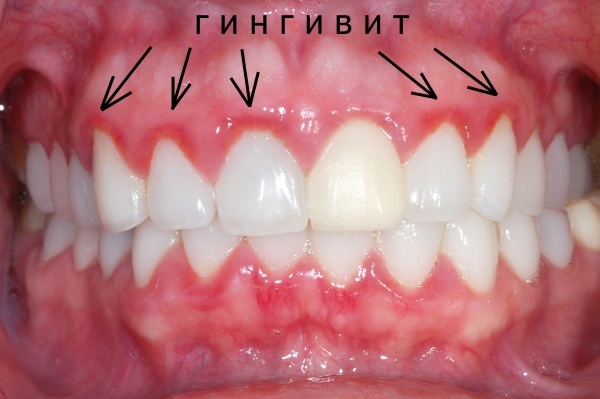
- periodic or persistent bleeding;
- swelling;
- hypertrophy;
- ulcers localized at the site of gum inflammation;
- pain while eating;
- itchy gums.
Also, a person with gingivitis may experience general weakness, bad breath, and swollen lymph nodes.
Possible reasons
The main reason is poor oral hygiene. If there is no gums and teeth care at all, then plaques appear on the tooth enamel - this is an accumulation of pathogenic microorganisms. As a result, inflammation develops, accompanied by bleeding, a change in the shade of the oral mucosa and severe edema.
Concomitant factors help to develop diseases more actively:
- smoking;
- tartar on the enamel;
- lack of vitamins in the body;
- the seal is incorrectly placed;
- malocclusion;
- immunodeficiency;
- stomach ulcer;
- damage to the oral mucosa due to burns.
Most often, gingivitis is found in children and adolescents under 15 years old, women carrying a baby.
How to treat
Disease of the gums and their treatment involves the use of such ointments:
-
Metrogyl. It is an antimicrobial agent due to two active ingredients: metronidazole benzoate and chlorhexidine digluconate. The first substance has an antibacterial effect against pathogens, and the second has antimicrobial and antiseptic effect. Apply the gel to the affected area of the gums with a thin layer up to 2 times a day. The duration of therapy is 7-10 days. You can not prescribe the medicine to children under 6 years old, with sensitivity to the composition. Failure to follow the recommendations provokes the development of allergy symptoms.
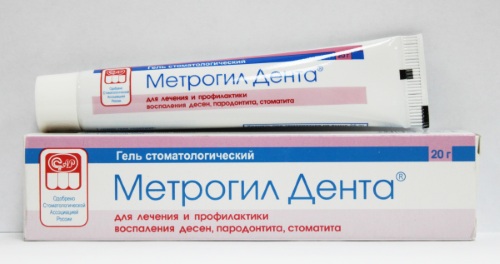
- Solcoseryl. The composition of the ointment includes the blood dialysate of young calves, purified from proteins. An anesthetic component, polidocanol, is also included. After applying the ointment to the gums, a thin protective layer is formed, which is not washed off by either saliva or food for 4 hours. The active ingredients contribute to the early healing of wounds and the rapid recovery of damaged tissues. The ointment helps to activate blood flow in damaged tissues, improve the flow of nutrients and oxygen. Ointment is applied to a clean gum, so the mouth should be rinsed first, spread over the gum with a thin layer. Apply up to 5 times a day. The course continues until the gums are completely healed. The drug has no contraindications. Among the undesirable manifestations, there is often a slight swelling, itching and burning. The cost of the drug varies within 300 rubles.
It is also recommended to rinse your mouth with Chlorhexidine solution. It is an antiseptic that helps to create a protective layer on the gums, preventing the harmful effects of pathogenic organisms. Stops the inflammatory process. Rinse the mouth with a solution twice a day after eating, the course is up to 10 days. A container with a solution will cost an average of 100 rubles.
Periodontal disease
This is a serious ailment in which the last stage of the development of the inflammatory process is observed. It is often the cause of the development of infections, gastritis, peptic ulcer or cirrhosis of the liver. And even more often, a person simply loses a tooth, and he can no longer lead his usual way of life.
Views
Periodontal disease is divided into several types, depending on the characteristics of the course of the disease:
- local - the lesion affects 2-3 teeth;
- generalized - the disease affects the entire lower or upper jaw.
The disease can go from a local form to a generalized one quickly, and all due to the lack of timely diagnosis.
Gum disease and how it is treated depends on the type:
- Chronic - the disease lasts for a long time, maybe even for years. At the initial stage, it is often confused with gingivitis and periodontitis.
- Spicy. It is detected in rare cases and more often in the elderly and indicates the presence of concomitant diseases of internal organs. In a number of situations, the disease is due to heredity.
Stages and degrees
Experts distinguish 3 stages of the course of the disease:
-
Lightweight. The patient does not have any symptoms or complaints, in rare cases, there may be a reaction to eating cold or hot food. You can only find an ailment in the dentist's office. This stage is best served by treatment.

- Average. The roots of the teeth are exposed by an average of 4 mm. The patient develops an unpleasant burning sensation in the mouth, reacts sharply to cold and hot food.
- Heavy. The roots are bare by 10 mm, food intake brings severe discomfort.
- Purulent. There are purulent deposits in the pockets in which food debris collects. Most of the teeth are mobile.
Symptoms
At an early stage, it is difficult to diagnose periodontal disease. The thing is that the disease can develop at a slow pace, without showing itself in any way.
Only at a later stage is it observed:
- exposure of roots;
- changes in the alveolar processes;
- bone atrophy.
Such changes are visible to the naked eye, frighten patients and force them to seek help.
But there are a number of signs that help diagnose periodontal disease without difficulty on your own:
- yellow plaque on the teeth;
- stones and mineralized deposits on the teeth with periodontal disease become larger;
- the gums itch and there is a strong burning sensation;
- the gums become pale;
- the roots of the teeth are visible;
- discomfort when eating hard, salty and sweet foods;
- teeth mobility is observed.
Possible reasons
Disease of the gums and their treatment directly depends on the reasons that provoked the development of the disease, and this can be:
- Insufficient oral care. Poor tooth brushing leads to the appearance of plaque on the enamel.
- Disrupted hormonal levels due to bearing a baby, menopause or puberty.
- Low immunity after a previous illness.
- Bad habits. Smoking has a detrimental effect on the health of the gums, which ultimately contributes to the development of periodontal disease.
- Unbalanced diet. Low consumption of fresh vegetables and fruits reduces immunity. As a result, the internal organs do not receive the necessary nutrition and begin to take it from the tooth enamel.
- Long-term use of certain medications that disrupt the normal flow of saliva, which in turn protects the gums from external factors.
How to treat
Gum disease and treatment begins with a dental examination and x-ray. Further, the specialist removes all deposits and stones on the teeth.
Further, the patient is recommended to undergo drug treatment, which includes taking:
-
Vitamins. Complivit is the best vitamin complex used in the treatment of dental diseases caused by vitamin and mineral deficiencies. It includes a group of vitamin B, folic and ascorbic acid. Vitamins should be taken in 1 pc. 1 time per day after meals. The dose can be doubled if the patient is taking antibiotics or the illness lasts for a long time. The course of admission is 30 days. The price of a vitamin premix is about 150 rubles.
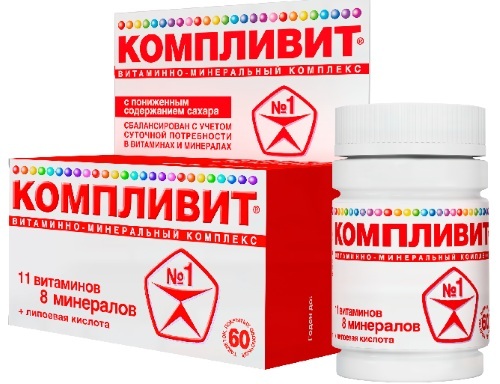
Complivit - Anti-inflammatory drugs. Holisal helps a lot. It is a gel with anti-inflammatory, antimicrobial and mild analgesic effects. The composition includes 2 main components: cetalkonium chloride and choline sacylate. They use the medicine topically, apply a thin layer on the gums 2-3 times a day, do not drink or eat for half an hour after the procedure. The cost of the drug varies within 300 rubles.
- Taking pills. Trental is a good and effective remedy that helps to normalize blood flow in the gum tissue, and also has a vasodilator effect. Dystrophic changes in periodontal disease occur due to a lack of oxygen in the tissues and a lack of nutrition. The drug is taken in the form of tablets 3 times a day, 100 mg, gradually increasing the dose to 200 mg. The course is individual. The price of the drug varies within 400 rubles.
Additionally, the specialist may recommend physical therapy:
- Laser. It helps to cope with inflammation in a short time, starts the regeneration of soft tissues, relieves swelling and fights infection.
- Electrophoresis. It is carried out with the use of calcium gluconate, which helps to remove dental hyperesthesia.
- Darsonvalization. With the help of a special device, it is possible to reduce the sensitivity of the teeth, remove pain and improve blood flow.
- Vacuum. The impact occurs on the affected capillaries, after which tissue nutrition improves, the atrophy process slows down and stops.
Traditional medicine will also help with periodontal disease:
- Rinsing. Sea salt will help remove pathogens. 1 hour l. dilute salt in 1 tbsp. water, rinse in several passes for 30 seconds. You can also use an infusion of kombucha. By rinsing your mouth with it, you can not only make up for the lack of vitamin C in the body, but also restore blood flow in damaged tissues.
- Teeth cleaning. You can take calamus, grate it, mix with toothpaste and brush your teeth with this compound every day, which will help to significantly strengthen the gums.
- Lemon and cranberry juice. They help stimulate the immune system, effectively fight bacteria, and have an anti-inflammatory effect. It is recommended to take ½ tbsp per day. in a day.
Periodontitis
This is a common disease that develops gradually and does not manifest itself at the initial stage. Periodontitis is an inflammation of the periodontal tissue, accompanied by discomfort, reddening of the gums and their further ptosis. The disease develops within 2-3 months and manifests itself against the background of other dental diseases.
Views
Along the way, the disease is divided into 2 types:
- Spicy. Symptoms develop rapidly, with severe pain and bleeding gums. It can worsen, manifesting itself in the form of abscesses and fistulas.
- Chronic. It develops slowly but steadily. Initially, there are no signs of the disease. If you do not take any measures, then the disease goes low and the treatment is difficult and long.
By localization, dentists divide the ailment into the following types:
- Focal. It develops at the site of injury to the gums. Having eliminated the cause and undergoing a course of treatment, the prognosis for recovery is positive.
- Generalized. The disease develops against the background of infection or injury to the gums, as well as an adequate immune response to the first factors, for example, the body may not produce antibodies that help to resist infection.
Stages and degrees
The disease can occur in several stages:
-
Lightweight. Structural changes are observed in the vessels and epithelium. The size of periodontal pockets reaches 4 mm, bone tissue is destroyed up to 1/3 of the length of the roots.
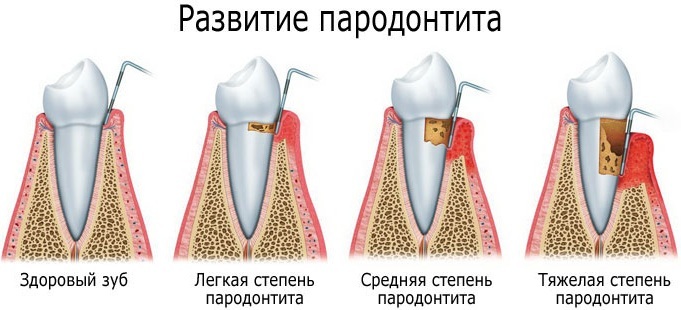
- Average. There is an active change in the structure of the periodontium, pronounced sclerosis of the stroma is observed, and granulation tissues appear. The pockets are 6 mm in size, the roots of the tooth are half bare, the teeth are mobility.
- Heavy. The partitions between the teeth are rapidly deformed, they disintegrate into several parts, the size of the pockets is 6 mm, the roots are bare a little more than half, there are processes of abundant infiltration, serious mobility teeth.
Symptoms
Among the first signs of the development of periodontitis are the following symptoms:
- bad breath;
- bleeding gums;
- yellow-brown plaque on the teeth;
- the appearance of periodontal pockets;
- unsteadiness of teeth;
- pain while eating;
- an increase in the distance between the teeth;
- increased sensitivity of the teeth.
Possible reasons
The main cause of the disease is improper and unsatisfactory oral hygiene, when optimal conditions for the development of pathogenic microorganisms remain in the oral cavity.
But there are other reasons as well:
- advanced form of gingivitis;
- malocclusion and crowding of teeth;
- frequent mucosal injury;
- smoking;
- kidney disease;
- low immunity;
- stress;
- heredity.
How to treat
After the diagnosis is made, the specialist conducts local treatment, which includes the following procedures:
- sanitation of the mouth;
- professional teeth cleaning;
- removal of stones, plaque, deposits;
- elimination of the cause of injury to the gums.
At home, experts recommend:
- Sanitize with an antiseptic. For example, Miramistin is suitable, which is available in the form of a solution and spray. Helps fight bacterial, fungal and viral infections. It is recommended to rinse the mouth with a solution twice a day. The cost of the drug is 300 rubles.
-
You can relieve puffiness with hypertonic drugs. Heparin and Indomethacin ointments are used. They are recommended to process the affected gums up to 3 times a day.
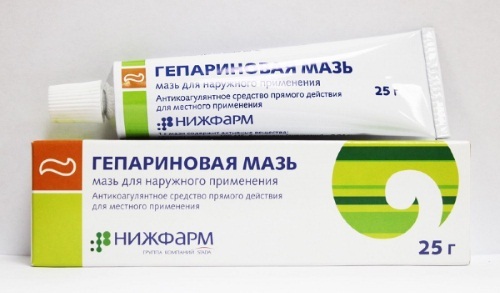
- Adsorbents. To adsorb pathogenic microflora and their waste products, it is necessary to stop the intoxication of the body. An excellent effect is given by applications with Polyphepan. It is produced in the form of a powder, which has an enterosorbent, detoxification, antioxidant and hypolipidemic effect. The powder is injected into the tooth pocket to stop the infection and relieve inflammation. The price of the powder is 150 rubles.
In addition, to speed up the therapy, the dentist can recommend physical procedures to the patient: ultrasound, electrophoresis, darsonvalization, massage, UHF therapy.
Gum disease can be serious. Infections without proper attention can affect both the respiratory system and the digestive system, and inflammation will lead to tooth loss. Treatment of gum disease should be carried out on time and only after consultation and under the supervision of a doctor.
Video about gum disease
Periodontitis, gingivitis, periodontal disease - reasons:



